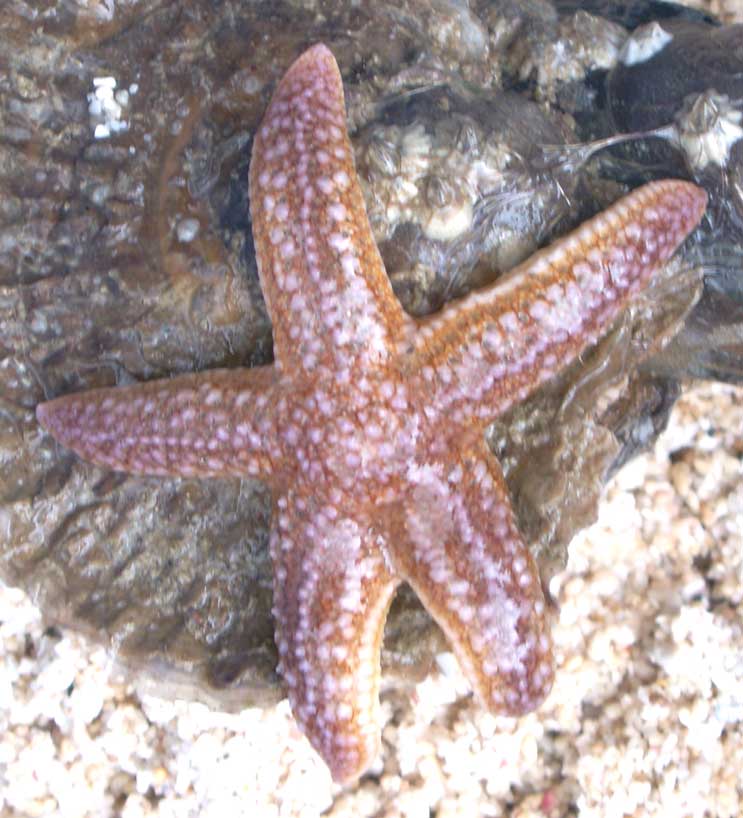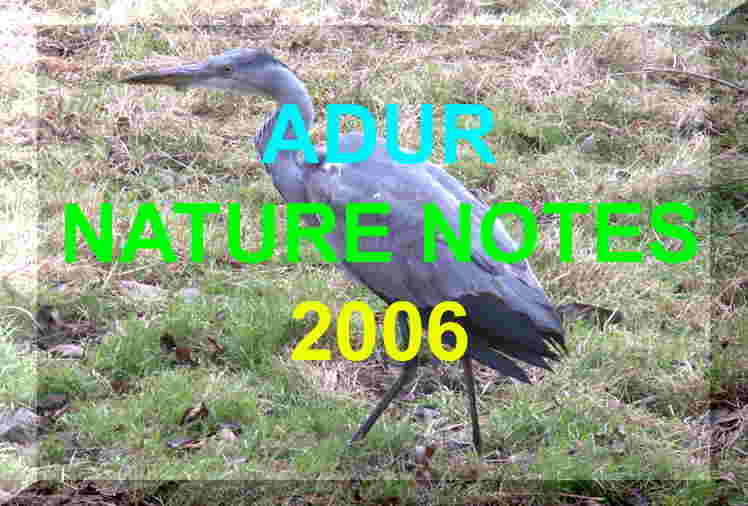INTERTIDAL
WILDLIFE REPORTS
Link
to Intertidal 2007
19
December 2006

More,
about sixty, small Goose Barnacles,
Lepas
anatifera, were discovered on a piece
of wood stranded on Shoreham
Beach (Ferry Road).
29
November 2006
About
a hundred small Goose Barnacles, Lepas
anatifera, were seen washed up attached
to a broken plastic fish box on the strandline
of Shoreham Beach (Ferry Road access)
after the recent southerly gales.

This is
the first time I have seen them washed at Shoreham in over 25 years, but
I expect they have been washed up and unrecorded before on frequent occasions.
There
were the usual millions of Slipper
Limpet shells, frequent Whelk
and Mussel shells, seaweed
and cuttlebones etc.
BMLSS
Barnacles
15
August 2006
A
morning low tide visit to the beach by the Half Brick
(East Worthing) was not very fruitful and the only fish of note was a baby
pipefish
discovered by Katherine
Hamblett. Althought it was too small to be positively identified it
was probably a Worm Pipefish, Nerophis
lumbriciformis, which was unusual
this far east up the English Channel, but it is increasing being discovered
along with the Daisy Anemone,
Cereus.
The largest of the local chitons, the mollusc
Acanthochitona
crinita was discovered on the underside of
a rock.
BMLSS
Rockpooling
 |
 |
13
August 2006
Drizzle
coincided with the low spring tide as the warm
weather gradually came to an end. The rocks on Kingston
Beach overlooking the sea below Chart Datum
were covered in green Enteromorpha
weed and potentially treacherous (i.e. slippery) and access was tricky,
which may explain a small but varied haul in the prawn net of occasional
medium-sized Rock Gobies Gobius
paganellus, some very tiny first year
Corkwing
Wrasse,
Symphodus
melops, and one small first year green Ballan
Wrasse, Labrus bergylta.
Full
Report
16
July 2006
Lancing
Beach at low tide produced very little but there were two Butterfish
Pholis
gunnellus, under the rocks, (most
of which were too tightly wedged down to be lifted) and a Short-legged
Spider Crab, Eurynome
aspera.
Full
Report
14
July 2006
A
Little
Egret was probing as the low tide receded
past the Chart Datum gauge on Kingston
Beach in the early morning (8:00 am),
and there were scores of large prawns Palaemon
serratus, and a variety of the usual
common fish and crabs, including the first Long-legged
Spider Crab, Macropodia rostrata,
of the year.
Full
Report
16
June 2006
Two
Little
Egrets were feeding on the mud and water
edge as the tide came in on Kingston Beach.
The
Edible
Crab Cancer pagurus,
Spiny
Spider Crabs Maja squinado,
and Velvet Swimming
Crabs Necora
puber, collected for Adur World Oceans
Day were returned to the sea.
15
June 2006
The
River
Walks TV company with Charlie Dimmick
filmed on Lancing beach (at the Shoreham end near Widewater),
referred to as Shoreham-by-Sea, featured shrimping
with Peter Talbot-Elsden
(British Marine Life Study Society).

The
documentary focuses on the River Adur and will be broadcast in October
2006.
10
June 2006

Adur
was one of the UK leaders in presenting an environmental exhibition of
World Oceans Day on Coronation Green, Shoreham,
as
part of the Adur Festival.
Adur
World Oceans Day 2006 was bathed in
a heatwave, but the show was over before the warmest day of the year so
far was recorded as the air temperature measured 25.8 ºC at 5:40
pm. The crowds were concentrated in the morning
because of the dubious alternative afternoon attraction of England
versus Paraguay in the World
Cup 2006.
Len
and Wayne Nevell and Samantha (British
Marine Life Study Society), and Marc Abraham
(PETS) presented the lobster
and large crustacean display, Andy Horton (BMLSS)
with the rockpool aquaria, John Knight and Kathy Eels (West
Sussex County Council Rural Strategy Unit) with the strandline display,
David and Marion Wood (FOWL)
with the shingle flora photographs, Dee Christensen (Nature
Coast Project) with the help of the Beach Wardens, Steve Savage (Sea
Watch Foundation) dolphins exhibit and ORCA (Organisation
Cetacea), the national cetacean group based in Newcastle-upon-Tyne.
Images
2006
Shoreham
Beach Nature Reserve was declared at Adur World Oceans Day 2006.
8 June
2006
By
Lancing Yacht Club the Mackerel
were jumping out of the shallow water and thousands
of very small fish from 25 mm long were stranded
all over the pebbled beach.
Report by Pat Bond (Duke of Wellington PH)
1
June 2006
A
Worm
Pipefish,
Nerophis
lumbriciformis, was discovered underneath
a large rock on Kingston Beach, the first
discovered in this location. This fish is unusual (scarce or rare) from
the Sussex coast. It is the only the second one I have discovered, the
previous one was found at Worthing
six years ago.
This
elongate fish is very easily hidden and may occur more often than it is
found. On a 1.4 metre low tide, the shallow seas
fauna showed more variety than expected with Sea
Gooseberries transparent in the sea and
only noticed when they appeared like globules in the prawn net and one
small shoal of Pollack fry
numbering about fifty and each small fish only 34 mm long.
Full
Report
BMLSS
Pipefish
Marine
Life of Sussex
31
May 2006
One
day later, the junior shrimp
net was repaired with a bolt and a wing-nut
and there were over a hundred Brown Shrimps
off Lancing beach (east Widewater),
a handful of South-clawed Hermit Crabs,
Diogenes
pugilator and a colourful Little
Cuttle Sepiola,
a small Solenette Buglossidium
luteum and flatfish
fry.

British
Marine Wildlife Gallery (flickr)
30
May 2006
My
junior (metre wide) shrimp
net broke under the weight of loose mixed
seaweed off Lancing beach (east Widewater)
and there were just two Brown Shrimps,
an isopod
and a South-clawed Hermit Crab,
Diogenes
pugilator.

BMLSS
Prawns & Shrimps
BMLSS
Shrimping
23
May 2006
After
the gales of yesterday, I was blown about by a Strong
Breeze (Force 6)
looking to see if anything interesting had been washed up on the strandline.
Seaweed was being washed in with every roller, mostly kelp, mostly Sea
Belt, Laminaria saccharina,
and large deposits were made at the Old Fort beach, but there did not seem
all that much more than normal on the strandline along the rest of the
Shoreham
Beach.
10
May 2006
A
"fleur-de lis" Portumnus latipes small
crab was caught in a shrimping net in the sandy
shallows of the sea off Widewater, Lancing. This was on a neap tide.
BMLSS
Crabs
17
April 2006
Two
large adult venomous Lesser
Weever, Echiichthys
vipera, fish were captured in the
shrimp net on Southwick beach at low tide,
with a 5-Bearded Rockling,
Ciliata
mustela, (this latter fish have been
caught plentifully by anglers recently).
Report
by Peter Talbot-Elsden
 The
rockpooling
season started late this year because of inclement weather. Under the first
boulder turned near Chart Datum on Kingston
Beach two small Common Starfish,
Asterias
rubens, were seen. These echinoderms
are only occasionally seen between the tides in
Sussex.
The
rockpooling
season started late this year because of inclement weather. Under the first
boulder turned near Chart Datum on Kingston
Beach two small Common Starfish,
Asterias
rubens, were seen. These echinoderms
are only occasionally seen between the tides in
Sussex.
British
Marine Life Study Society
15
April 2006
At
6:00 am, the Peregrine
Falcon was making a tremendous racket
(a sound once heard and never forgotten) on the Shoreham
Harbour Power Station chimney whilst I
was shrimping. In the swell, I caught a pint of Shrimps.
Report
by Peter Talbot-Elsden
5 March
2006
A
shrimping
expedition (push-net) to the sandy shallows of Southwick
beach produced four small
Sand-eels,
Ammodytes tobianus, but these were so
small that most of these elongate fish would have escaped through the netting.
Small fish fry, probably 5-Bearded Rockling,
Ciliata
mustela,
were caught in the net as
well.
Report
by Peter Talbot-Elsden
29
January 2006
A
Triggerfish,
Balistes
capriscus,
had washed up dead on the beach
west of Grand Avenue Worthing West Sussex, and the fish was beginning to
smell a bit.
NB:
Triggerfish
are a southern warm water fish that reach their most northerly point of
distribution in the English Channel and some of the fish may die of cold
during the winter months.
Marine
Life Reports (Sussex)
BMLSS
Triggerfish
Adur
World Oceans Day




